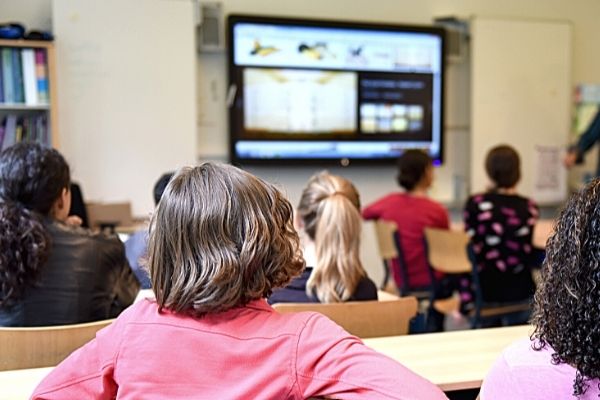Good quality education is one of the most precious gifts you can give to a child as a parent and a teacher, as it will open up a world of opportunity for them. However, not all learning is created equal. Various factors may influence the quality of education that learners receive, including the curriculum, their teachers, the facilities at their school, etc.
One of the ways a child's education may be enhanced is through the use of smart boards. In this piece, we'll be looking at smartboards, exploring their features, uses, advantages, and possible disadvantages when used to teach elementary school classrooms.
What are Smart boards?
What we refer to as a smart board is basically the combination of display screens and the traditional whiteboard. They are interactive electronic devices that allow you to display information in the same way as a conventional monitor display while allowing interactivity through touch. They come with dedicated software installed in the operator's computer, then linked to the board.
Common Features in Smart Boards
Some of the features that you can find in most smart boards are:
- Web Browser: They can display and navigate through websites and online resources
- Integrated Speakers: They have speakers built into them so that audio files, music, movies, and animations can be played back with full sound fidelity
- Wireless Screen Sharing: Some boards can be hooked up to your computer without the need for cables through Bluetooth or Wi-Fi
- Simultaneous Writing, Touch, and Erase Points: Like smartphone touch screens, smart boards will allow you to use various inputs and perform multiple actions such as writing, drawing, and erasing
How to Use a Smartboard in an Elementary Classroom
There are plenty of ways to use a smartboard, as these versatile devices have a broad range of functionality. For example, for elementary school classrooms, these might include:
- Group Activities: Elementary classrooms favor communal or group activities. Smartboards can be used to introduce lively and engaging activities into a classroom.
- Music and Singalongs: Children love music, and smartboards can have singalong music programmed onto them.
- Help in delivering Creative Movement Lessons: At this age, classrooms are full of energy and won't like sitting still for very long, but smart boards can introduce motion into your classroom with lessons that encourage controlled motion in the class, thus keeping learners active and engaged.
- Educational Games: There are plenty of games designed to help learners grasp lessons in mathematics, English, social studies, and more that can be loaded up onto a smart screen.
- Visual Learning: A picture, as they say, is worth a thousand words. Using PowerPoint slideshows, detailed images, and engaging graphics will help your class internalize and grasp your message much faster than they would otherwise.
- Attendance: To keep track of your students and help them go through routine activities such as taking attendance, lunch count, and so on, smart boards can be highly useful.

Advantages of Using a Smart board in Elementary Classrooms
Smartboards can enhance the learning process and experience for teachers and students alike in many ways, including:
- Broad Graphics Options: Multimedia visuals such as pictures, video, slides, and audio make the learning experience vibrant and engaging for learners.
- Collaboration: Learners can participate in group activities, which are highly effective learning methods for elementary-age learners.
- Saving Capabilities: Educators are able to save their lesson progress and load it up on their next session, saving them time and allowing for seamless syllabus continuity.
- Student Engagement: Young learners are easily bored and distracted, but smart boards can grab and hold students' attention for much longer.
- Increased Learner Knowledge: Young learners need their lessons to be as engaging and exciting as possible to internalize and understand the lesson. Smartboards are excellent tools for this purpose.
- ICT Head Start: Knowledge of Information and Communication Technology is a vital component of life in today's digital world. Using smart boards in elementary classes will give learners a head start in this area.
- Paperless Learning: Using a smartboard can be a great way to help protect the environment by reducing the amount of paper used in your classroom and teaching your students an early lesson in environmental responsibility.
- Interactivity: Learning is much more effective when interactions go both ways rather than exclusively from the teacher to the learner. Smartboards enable much higher levels of interactivity than traditional methods made possible.
Disadvantages of Smart boards for Teaching Children
Even though there are plenty of advantages that smart boards come with, there are also some downsides that you might need to consider. These include:
- User-Friendliness: Depending on their level of tech-savviness, some operators might have trouble running a smartboard effectively.
- Purchase Expense: Depending on what type of board you select, they can be somewhat expensive, with typical prices ranging from a few hundred dollars to over six thousand dollars.
- Software Difficulties: As with all electronics and computer systems, smartboards are prone to software bugs and issues that might disrupt learning activities.
- Delicate Hardware: There is a risk of breakage when using such delicate hardware, especially in a setting with so many children around. Fixing smart board breakage can be a complex and costly exercise.
What Did Teachers Use Before Smartboards?
Smartboards are a relatively new technology, but they are not so far from what teachers used to use in their classrooms. In the past, teachers sued traditional chalk and blackboard setups. For the most part, teachers have switched to whiteboards since they are easier to keep clean and offer brighter views. Smartboards are the evolution of the whiteboard to include new technological features.
Final Thoughts
Keeping abreast of new technology is key to success in this fast-moving world. Using smart boards in elementary school classrooms can help you introduce this technology to young students to help develop and educate them. In addition, teachers will find it much easier to incorporate a broader, multi-channel approach to learning that will give them more options when it comes to their teaching style. All in all, it's a significant step up from traditional chalkboards and whiteboards.

